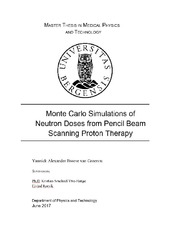| dc.description.abstract | Introduction: Proton therapy is a more advanced form of radiotherapy that allows better dose conformity to the tumor and a homogeneous dose distribution. A side effect however is the production of secondary neutrons generated by the beam particles through nuclear interactions. Neutrons contribute with an unwanted, additional dose, and because neutrons are highly penetrating, they can reach organs and tissue far outside the treatment field. As these particles can have a very strong biological impact, a small dose can lead to a high risk of radiation-induced cancer and other secondary malignancies. Methods: In this thesis, a cranio-spinal irradiation treatment using intensity-modulated proton therapy for a pediatric medulloblastoma patient was simulated by using the Monte Carlo simulation code FLUKA. Two obliquely opposed proton beams with energies 175 – 190 MeV were used for the cranial fields, and 135 – 150 MeV proton beams for the spinal fields. The therapeutic biological proton dose was 23.4 Gy(RBE). The neutron absorbed dose and ambient dose equivalent were scored for organs at risk and the PTVs. In the treatment, organs at risk were thyroid, liver, colon, stomach, lung, kidneys, bone and bladder. The dose distributions were plotted in a dose-volume histogram, visualized in two-dimensional plots and one-dimensional graphs of dose as a function of depth inside the patient. Results: The brain was the heaviest exposed organ, receiving a neutron dose of 4 mGy on average. Maximum and minimum doses were 5.7 mGy and 3.1 mGy respectively. The remaining upper organs: eyes, esophagus, trachea and thyroid, all received mean doses around 2 mGy, and maximum doses of 2 -3 mGy, except for the trachea which received 6 mGy. The lower organs: stomach, liver, kidneys, heart and lungs, received maximum doses of 0.3 – 1 mGy. The mean absorbed doses, as well as the equivalent doses were the highest in the brain (236 mSv), and followed by the same upper organs (140-155 mSv). The lower organs received mean dose equivalents of 70 - 80 mSv. Conclusion: The brain was most heaviest exposed, and received in overall the highest neutron absorbed doses and dose equivalents. The remaining upper organs were less exposed, but the dose distributions are still relatively high compared to the lower organs. The lower organs receive neutron doses, however, they were significantly lower than the organs located in the upper body. The neutron dose decreased from the upper to the lower part of the body. The results obtained in this work could be used as input data in models for risk estimation of radiation induced cancer, and could provide relevant information when different treatment alternatives are to be considered. | en_US |
